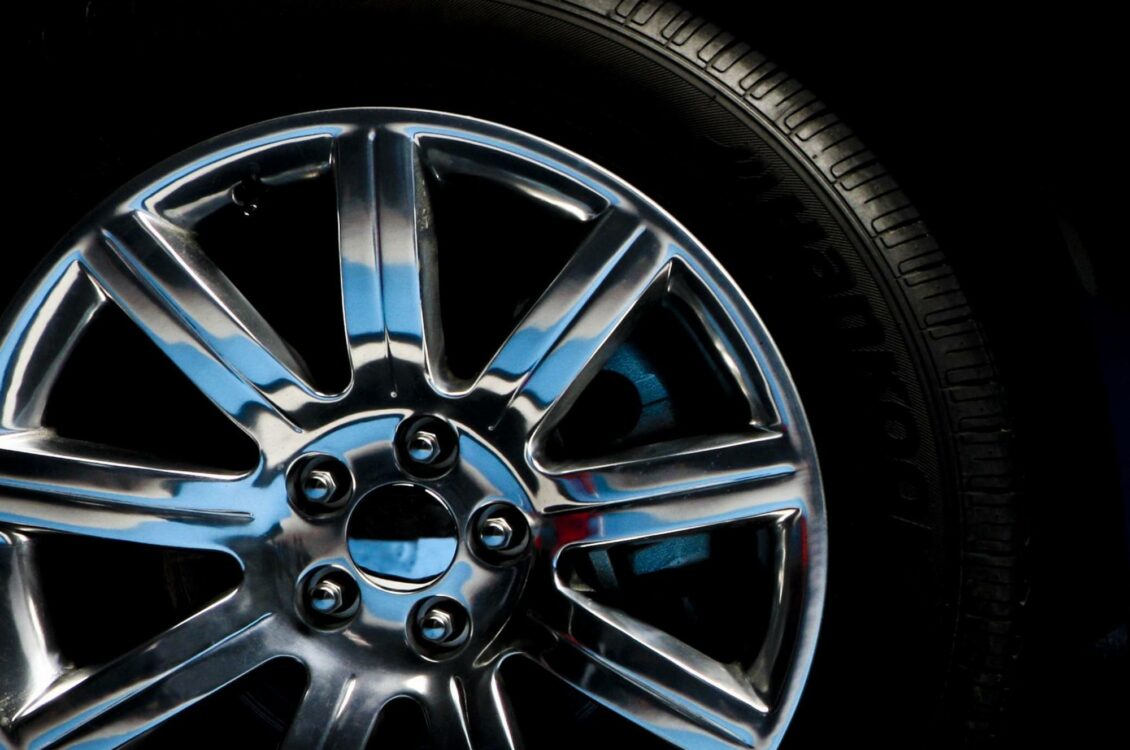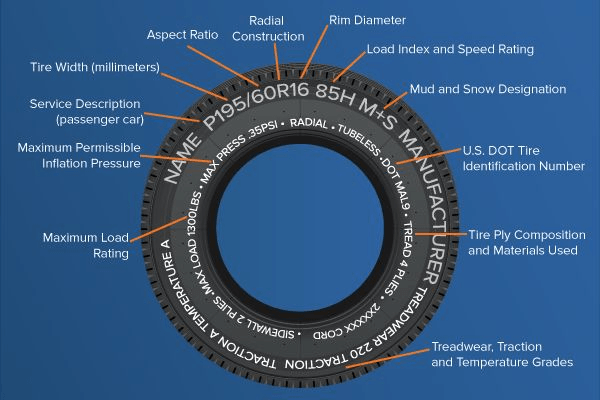
Buying new tires can be a confusing chore. What do all those numbers mean? Should I go with winter tires or all-season? And, of course, how do I know when I need new ones?
Taking care of your tires and maintaining good driving habits can help extend the life of your tires, but eventually you’ll need a new set. That’s why we’ve put together this comprehensive tire buying guide with all the information you’ll need to help make an informed choice. Learn how to buy tires by following the steps below.
1. Inspect your tires
Vehicle manufacturers typically recommend that your tires be changed every six years, regardless of wear and tear. Check your owner’s manual to see what your car maker suggests.
Have a mechanic inspect your tires regularly for signs of wear or damage. You should also check them out regularly, as well. Look for the factors below:
- Tread depth – Place a penny upside down into the treads or grooves. If you can clearly see Lincoln’s entire head, your treads are likely worn and it may be time to replace them.
- Sidewall cracks – Check for cuts or deformations in the sidewalls. If you see any grooves, your tire could be on the verge of a leak.
- Bulges or blisters – A noticeable bulge or blister could indicate a weak outer surface.
- Vibration – Does your car vibrate noticeably when you’re driving? This could indicate problems now and potential danger down the road.
If you need new tires, buy the size and type specifically for your car. Mixing different tire types could not only cause damage, but could also be dangerous.
2. Determine the right tire size
On the sidewall (the outer and inner sides) of a tire, you’ll find the following information:
- Tire Specs – Size, construction and speed rating. Speed rating is the approximate speed a tire can safely maintain over time. The higher the rating (A is the lowest and Y is the highest), the better the handling and control. However, a higher speed rating may result in a shorter tread life. Check with your carmaker for the proper speed-rated tire for your model.
- Department of Transportation Safety Code – This code certifies the tire manufacturer meets U.S. Department of Transportation tire safety standards. It is followed by your tire’s ID number, plus information about where and when the tire was manufactured.
- Uniform Tire Quality Grading (UTQG) – The testing method used to grade a tire’s tread wear, traction and temperature.
- Icons – Features a tire’s unique benefits. For example, “M+S” means the tire meets the Rubber Manufacturers Association standards for mud and snow.
3. Read a tire’s sidewall
The diagram below shows where you’ll find this information on a tire.

Note the code on the sample tire above is P195/60R16 85H. The table below shows what each abbreviation in the code means.
| P | Service Description P = “passenger car”LT= “light truck”ST = “special trailer”T = “temporary” |
| 195 | Tire Width Tire’s section width – distance from sidewall edge to sidewall edge. The higher the number, the wider the tire. |
| 60 | Aspect Ratio Tire’s section height compared to its section width. Lower numbers mean a short sidewall with improved steering & handling. |
| R | Internal Construction R = radial construction |
| 16 | Rim Diameter Wheel diameter, in inches, for which the tire was sized. |
| 85 | Load Index Measurement of how much weight each tire is designed to support. The larger the number, the higher the load capacity. |
| H | Speed Rating Speed the tire is designed to run for long periods.S = 112 mphT = 118 mphU = 124 mphH = 130 mphV = 149 mphZ = Over 149 mphW = 168 mph Y = 186 mph (Y) = Over 186 mph |
Another factor to consider in buying tires is tread-life warranty– an estimate based on the type of tire and the number of miles it can be expected to travel under normal driving conditions.
4. Choose the type of tires
Now that you know tire terminology, consider the type of tire best suited for you and your car.
| Type of Tire | Description | Speed Ratings | Tread-Wear Warranty (miles) | Best For |
| All-season tires | Cost-effective tires offer a smooth ride, long tread wear and adequate traction on dry and wet conditions | None, S, T | 40,000 – 100,000 | Cars and minivans
Older cars & climates that rarely drop below freezing temps |
| Performance all-season tires | Typically offer better handling and braking than regular all-season tires | H, V | 40,000 – 60,000 | Cars & minivans
Newer cars |
| Ultra performance tires | Provide good handling and steering in wet and dry conditions | ZR, W, Y | 30,000 – 40,000 | Cars & minivans
Upscale sedans or sports cars |
| Summer tires | The softer rubber provides maximum traction on dry and wet roads in warmer weather | — | — | Cars & minivans
Warmer climates |
| All-terrain tires | Best for paved roads and light-duty, off-road use | S | 40,000 – 60,000 | Light trucks & SUVs
Fit for most weather conditions – good for SUVs & other 4-wheel drive cars |
| Winter tires | Tread is designed for snow and ice; rubber can withstand freezing temps | Q, S, T | None | Areas that experience wintry conditions |
| Performance winter tires | Enhanced winter traction offers high-speed handling and higher levels of snow and ice grip | Q & up | None | Areas that receive an increased amount of snow and ice |
When selecting tires, consider:
- Weather conditions you commonly drive in
- The worst weather situations you could expect to face
- Where you usually drive – city streets, highways, etc.
- Your driving style
Always make sure you select tires that are appropriate based on your owner’s manual and your tire distributor’s recommendation.
Here are some frequently asked questions about tires:
5. Common tire questions
What driving habits negatively impact a tire’s life?
- Taking curves and corners fast
- Abrupt accelerating and braking. This can cause excessive heat that wears the tire out more quickly
- Hitting curbs, potholes, etc.
How do you extend the life of a tire?
In addition to driving responsibly, there are other ways you can prolong tire life:
- Check tire pressure regularly
- Rotate tires regularly as outlined in your owner’s manual to help equalize tread wear
- Check wheel alignment as recommended by your carmaker
What is the correct air pressure for your tires?
Find your optimal operating tire inflation pressure in the owner’s manual and on a sticker located on the inside of the driver’s door.
Can you mix tire types?
Performance is best when all 4 tires are the same size, tread pattern and age. Tires that vary in those factors can cause handling and stability problems. However, some cars have different size tires in the front and rear, so check your owner’s manual.
Can you mix tires with different speed ratings?
Generally, not recommended. It could affect handling and maximum speed limit.
When should you use winter tires?
Winter tires are generally used when the temperature remains consistently near freezing. Winter tires can provide improved grip on icy and snowy surfaces, and are one way you can prepare your car for driving in the snow.
Should winter tires be used only in snow?
Usually, if temperatures drop and you’ll be driving in rain, ice, snow or other wintery conditions. When temperatures stay above freezing, change to summer or all-season tires.
Can you use summer tires in the winter?
This is not usually recommended. Cold weather can cause softer summer tires to lose grip, develop cracks and shorten tire life.
Should you purchase used tires?
This is not typically recommended. You may be unaware of past hazards or mistreatment the tires underwent.
Choosing the right tires and knowing how to care for them is critical to safe driving. Be prepared for a flat tire, find out how to fix a flat tire without a spare and make sure your car insurance provider offers roadside assistance.



